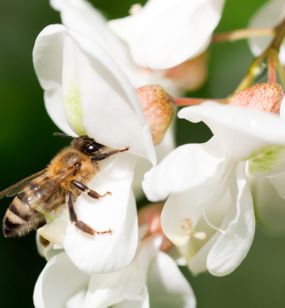So where does honey come from?
Bees produce honey as food stores for the hive during the winter months when flowers are not in bloom and therefore there is little nectar available.
The nectar collected by the honey bees from flowers and plants is carried to the hive or nest and is then passed to worker bees, who prepare it for storing by adding enzymes.
As the nectar is transferred to the wax storage chambers, water is evaporated away, and it is this process, combined with enzyme activity that converts the nectar into honey.
A hive only needs 20-30 lb of honey to survive an average winter which means that the extra honey can be harvested. A strong colony can produce 2-3 times more honey than they need.
What is honey exactly?
Honey is a complex mix of:
- (80%) natural sugars
- (18%) water
- (2%) minerals, vitamins, pollen and protein
Of honey's 80% natural sugar content, around 70% is made up of fructose and glucose. The balance of these two sugars determines whether a honey is clear or set. Both types are equally pure and additive free.
What is the difference between clear and set honey?
The higher the fructose content, the longer the honey will remain liquid. Some honeys contain more glucose than fructose and, therefore, are very likely to crystallise swiftly.
There is no difference in the taste or nutritional value of these two states. Honey can be restored to a liquid state by standing it in warm water for an hour or so.
How many honey varieties are there?
 Bees can fly up to six miles, although one or two is more common. Within this radius, depending on the flower variety, they can gather nectar from many different types of flower (polyflora honeys) or from one kind of flower (monofloral honeys).
Bees can fly up to six miles, although one or two is more common. Within this radius, depending on the flower variety, they can gather nectar from many different types of flower (polyflora honeys) or from one kind of flower (monofloral honeys).
Besides classification by floral source, honeys can also be described according to geographical origin, from a particular country or region. This is because a honey of the same flower type will still vary from country to country because of difference in climate and soil; a polyfloral honey from one country may have a distinct combination of plant source to give a unique flavour.
- Monofloral: Honey made primarily from a single source including: Acacia, Pine, Orange Blossom, Lime, Rosemary, Thyme, Sunflower, Clover, Leatherwood, Eucalyptus
- Polyflora: Honey made from the nectar of many different flowers
- Blends: Combinations of different types of honey blended to achieve a particular taste rather like a blended tea or whisky.
How honey is packed commercially? Your questions answered
Is it true that the cheaper the honey the more it has been refined?
There is no fundamental difference between blended honey and more expensive monofloral honeys. The extraction process - that is when honey is taken from the comb - is essentially the same for all types and grades of honey.
Why is honey warmed before packed into jars?
All honey is slightly heated to melt naturally occurring crystals and filter out very small organic impurities from the hive e.g. wax. This is carried out as part of the normal production process and helps to protect the natural taste and qualities off pure honey in every jar.
What is 'Flash Heating'
Honey is sometimes put through a heat exchanger for about 30 seconds to make sure that it is liquid. This does not damage the natural enzymes or nutrients.
Are sugar and water sometimes added to honey?
Sugar and water are never added to honey.
Does heating destroy the natural flavour of honey?
Quick and/or gentle heating does not destroy the natural flavour of the honey.

